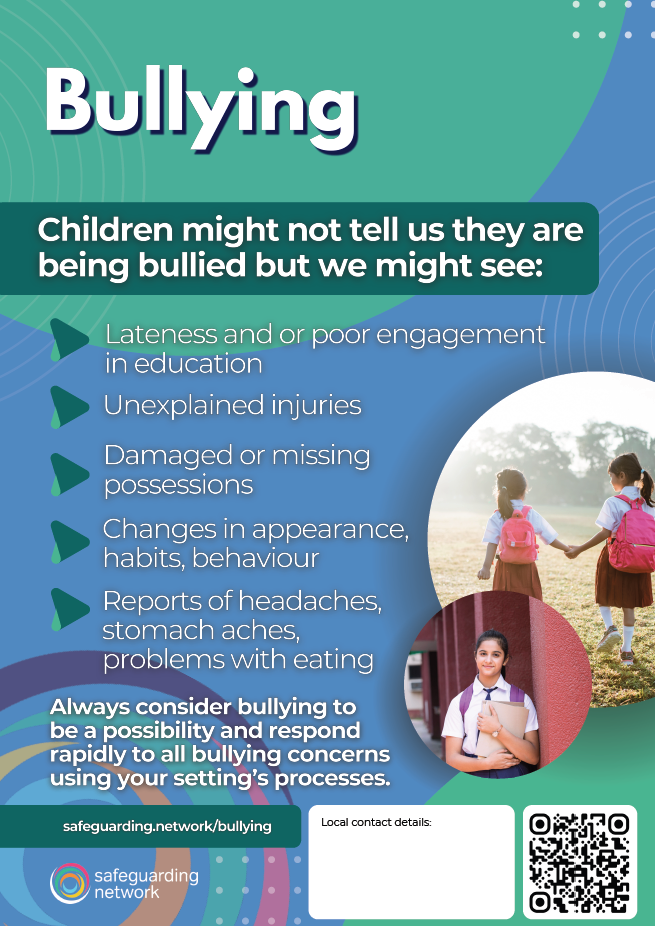Introduction
Bullying is often a barrier to learning and can negatively impact all areas of child and adolescent development and wellbeing. We must remember that bullying also negatively affects bystanders and those children and young people who enact the bullying behaviours.
For many children and young people, the issue of bullying is felt to be something that they should deal with themselves. They feel adults are not going to take them seriously and will most likely make things worse. However, we know that bullying has an enduring impact on children and young people right through to their adult life and should be taken as seriously as other allegations of abuse or neglect.
Need more?
Thank you for visiting our resources pages. These are free to everyone as is our fortnightly safeguarding bulletin – general safeguarding information is too important to restrict. Become a member to access lots more, including training materials for you to deliver in-house on each topic in Keeping Children Safe in Education.
Sign up for FREE fortnightly bulletin.
What about training?
We can deliver training for your setting on this and other subjects via online platforms, or face-to-face in certain areas. Just get in touch to discuss your requirements.
Bullying can cover a wide range of issues, and as identified on the government’s website, some forms are illegal (e.g., violence or assault, theft, repeated harassment and hate crimes) and should be reported to the police. Child-on-child abuse can also include bullying.
Bullying can occur across all areas of a child’s life – out in the community, in their education setting and wherever they are online.
Keeping Children Safe in Education states that education settings should have ‘a behaviour policy which includes measures to prevent bullying (including cyberbullying, prejudice-based and discriminatory bullying’. VotesForSchools asked their young voters to reflect on the policies and schemes in place to tackle bullying in schools. 64.9% of primary school voters said their school does enough to tackle bullying, while 70.2% of secondary school voters said theirs doesn’t.
Definition of bullying
“Bullying is behaviour by an individual or group, repeated over time, that intentionally hurts another individual or group either physically or emotionally. Bullying can take many forms (for instance, cyber-bullying via text messages, social media or gaming, which can include the use of images and video) and is often motivated by prejudice against particular groups, for example on grounds of race, religion, gender, sexual orientation, special educational needs or disabilities, or because a child is adopted, in care or has caring responsibilities. It might be motivated by actual differences between children, or perceived differences.”
Prevalence
Pupil bullying and wellbeing questionnaires completed by approximately 65,000 students in England as part of the Anti-Bullying Alliance's United Against Bullying programme found that:
- Nearly 1 in 4 students reported they were bullied a lot or always
- Students in receipt of Free School Meals (28%) and those with special educational needs or disabilities (29%) were significantly more likely to be frequently bullied
- 6% of students reported frequently bullying others
- 5% of students reported frequently being bullied online
Adapted from Anti-Bullying Alliance
Types of bullying
Bullying can present in many forms, some of the more common types are below:
- Physical bullying - hitting, kicking, tripping or the destruction of a person’s property.
- Verbal bullying - insults, teasing, name-calling, sexual harassment or prejudice based/discriminatory language, including threats.
- Covert bullying - can include creating rumours, dirty looks, mimicking, encouraging others to have a poor opinion of someone, sharing personal information without knowledge or consent.
- Alienation - treating the person like an outcast, ignoring them and not including them in things, encouraging others to do the same.
- Prejudice based/discriminatory bullying - any type of bullying that is motivated by hostility to certain individuals or groups due to their disability, race, religion, sexual orientation, gender identity or other perceived difference.
- Online bullying (cyberbullying/bullying through use of technology) – all of the above forms of bullying can be enacted through technology and often children experience bullying in person and online at the same time. As with bullying which occurs in person, bullying through technology can sometimes be a crime. An example of this would be encouraging someone to carry out serious self-harm by sending someone links to pro-self-harm or pro-anorexic websites.
Children may know who is bullying them online or they may be targeted by someone using a fake or anonymous account. The use of technology can increase the ways in which bullying occurs and the frequency of incidents. For example, hurtful or private images and untrue/unkind comments can be shared very easily to many people and the victim is always accessible if they are online somewhere.
The use of technology can also compound the impact upon the victim. For example, images and written comments can be almost impossible to erase entirely once shared widely, the anonymous nature of some bullying means the victim does not know who they can trust, and it can feel like there is no escape when bullying can occur any time or anywhere.
It is vital that bullying is also considered when thinking about all online safety for children and young people.
Vulnerabilities
Whilst bullying is never the victim’s fault, a consistent message from research is that a child’s differences and perceived differences are often the focus of bullying. This might include:
- having special education needs and or disabilities
- identifying as LGBTQ+ or appearing to
- being from a lower-income family
- being from a higher-income family
- race and or ethnicity
- religion and or faith
- being academically very able
- being academically less able
- interests and hobbies
- appearance and or mannerisms
- family experience – for example, being adopted, having a parent with care and support needs, being a Child in Care, having a parent in prison, having same-sex parents.
In most cases, those who bully others do so to gain a feeling of power, purpose and control over others. Children may bully others due to:
- stress and trauma – they may have experienced a traumatic event like parental imprisonment or a family bereavement.
- low self-esteem – to mask how they feel about themselves they focus on others and or making someone else feel worthless helps them feel better by comparison.
- being bullied – in a cycle of negative behaviour, some bully others.
- a difficult home life – they may be experiencing neglect or abuse or be exposed to abusive adult relationships.
- poor guidance – without access to education and guidance, bullying, hate speech and violence can be seen as normal behaviours.
- poor relationships – those in unsecure relationships may be persuaded to bully others to feel accepted.
The impact of bullying
In the shorter term, the impact of bullying might include:
- injuries and loss of property
- lack of engagement in education including non-school attendance
- change in eating habits
- trouble sleeping
- friendship problems
- loss of interest in hobbies and activities
- trouble concentrating
- anxiety
- change in behaviour
In the longer term, the impact of bullying might include:
- Depression and anxiety
- Suicidal thoughts
- Self-harm
- Low self-esteem
- Trouble forming relationships
- Not fulfilling academic potential and aspirations
- Substance misuse
- Going missing from home
Spot the signs
- unexplained injuries
- distress/anxiety
- broken or missing possessions or damaged clothing
- changes in appearance, habits and or behaviour
- complaining of headaches and or stomach aches, problems with eating
- lateness and or poor school attendance
- a change in attainment or engagement in lessons
- a change in use of online spaces and technology
A whole-setting approach
Bullying needs to be addressed consistently and to do this requires a whole-setting approach. This should be
cohesive, collective and collaborative including the whole setting community – students, parents/carers, staff and leaders should be actively involved in identifying bullying and taking steps to challenge it.
- be designed with direct input from students – students have a good understanding of how bullying impacts them and their peers, their active involvement is vital and students need to have a variety of safe ways to report bullying.
- be consistent in application – there should be processes in place to ensure that the responses to bullying are applied consistently by everyone.
- embedded across the curriculum – opportunities for education and guidance regarding respect, kindness and positive relationships should be available within all teaching and learning.
- considerate of the different spaces bullying can occur – this might mean strategies to monitor places within the education setting where bullying might occur. It’s also important to consider online spaces and use of technology.
- supported by clear and understood policies – policies should help everyone know what to do if they have concerns about bullying and outline what will happen to stop bullying from repeating.
What to do
Keep talking - maintain effective communication with students in relation to the subject of bullying and how difference and diversity can be respected and celebrated in the setting.
Create a safeguarding culture - ensure children and young people feel secure and able to express their emotions and concerns, where they know they will be listened to, and can ask for the help they need.
Ensure any incident of bullying receives a rapid response – offer a variety of ways for students to be able to share concerns and follow your setting’s policy and procedures.
Be aware of vulnerabilities to participation and victimisation – know your students and provide support and intervention as needed.
Create an environment based on equality and informed choice – provide information to allow pupils to make informed choices. It’s well established that success in learning within a supportive setting community can tackle prejudice and inequality.
Spot the signs and know what to do – you know the children and young people you work with. Be aware of the signs and how to recognise them. Follow your safeguarding procedures and have confidence in your ability to consider bullying as a possibility.
Take action – any concerns should be raised with the designated safeguarding lead. If a child is in immediate danger call 999.
Building partnerships with parents and carers
When working with parents and carers, practitioners should prioritise a child-centred approach, fostering partnerships to ensure understanding, support and safety.
Remember:
- Collaborative efforts are crucial, especially in cases of suspected harm.
- Practitioners must engage effectively with diverse families, demonstrating empathy, respect and cultural awareness.
- Communication should be clear, inclusive and accessible. Encouraging parental/carer involvement in decision-making and valuing their input is essential.
- Involving families and communities in designing processes fosters a holistic approach to safeguarding children.
- Continuous reflection and adaptation based on feedback from parents and carers enhance practice effectiveness.
- Have you considered if:
* the setting’s behaviour policy and any strategies related to bullying are easy to understand and accessible to all parents and carers, with consideration given to things like literacy, language and disability?
* the setting has easy ways for parents/carers to report bullying concerns, should they have any?
* the parents/carers of those students who have been bullied are always offered the space to discuss their child’s needs and any support which their child might benefit from?
* the parents/carers of those students who have bullied are always offered the space to discuss their child’s needs and any support which their child might benefit from?
FREE bullying poster
This downloadable resource raises the profile of safeguarding for your staff team. For use in staff rooms, on safeguarding boards or on the back of toilet doors the poster includes tips, a space for local contact details together with a link and QR Codes to this resource page. Find the poster in the resources below.
DSL Training Materials
-

Bullying and Hate Crime Presentation
-

Bullying and Hate Crime Presenter Notes
-

Bullying Handout
-

Bullying Quiz
-

Bullying Quiz (Answers)
-

Bullying Scenario (Early Years)
-

Bullying Scenario (Early Years) - DSL Information
-

Bullying Scenario (Primary)
-

Bullying Scenario (Primary) - DSL Information
-

Bullying Scenario (Secondary)
-

Bullying Scenario (Secondary) - DSL Information
-

Bullying Scenario (FE / 16+ settings)
-

Bullying Scenario (FE / 16+) - DSL Information
-

Bullying Scenario (SEND)
-

Bullying Scenario (SEND) - DSL Information
-

Bullying Scenario (Care)
-

Bullying Scenario (Care) - DSL Information
Resources
-

Bullying Poster
-

Fostering good relations: guidance for schools
-

Anti-racism and mental health in schools
-

Anti-social media
-

Draw My Life: Mo’s bullying story
-

Addressing School Avoidance
-

Coronation Street – Bethany is bullied at school
-

Preventing and tackling bullying
-

Jake’s story: Being bullied
-

Approaches to preventing and tackling bullying: Case studies
-

Teach about bullying
-

Advice for adults working with children
-

Focus on: Bullying
-

Together against school bullying
-

Bullying prevention tool
Save time and improve your safeguarding approach…
Bite-size training materials to share with your staff every month.
Support to explore and develop your safeguarding culture.
A huge array of resources and professional experience at your fingertips.
Get in touch now for a personal tour of the site and details of membership benefits.
We look forward to working with you.


